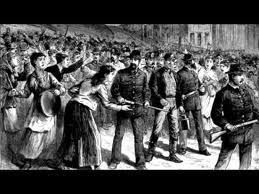(unvoiced): "Henry 5: The Worst Noel"
(voiced): "The holidays are just another excuse / For the world to intrude on my solitude. / I live with a few other cats [camera pans across four tiny stockings hung from the mantel each with a picture of a cat's face looking adorable, taped to the stocking] / and each annoys me in a unique way. [camera reaches Henry's stocking, with a picture of him looking annoyed] / They lend no credence to my major awards [shows the leg lamp from A Christmas Story, a bulldog figurine and a trophy with a gold leaping cat figure] / Naps are my only respite [shows him drifting off to sleep]. / In my dreams I can finally be alone. / [dream sequence begins, showing Henry in color with out-of-focus colored lights falling behind him in an abstract background] No, no, no. What are you doing here? [camera cuts to white cat with same background] / I must have eaten something bad / There's more of whitefish and tuna in gravy than grave about you / So, why are you here? / [white cat paws around, then looks over its shoulder into the distance] Look, it's me as a kitten. I was so innocent then. [snapshots of the kitten Henry appear on screen screen one by one] / I knew nothing of the cruelty of the world / Your simple mind is much the same as I was then. / [to the white cat] Perhaps I am too harsh with you. / I suppose- oh! come on... [cuts to white cat licking its own butt] / [white cat dissolves, grey cat appears] Do I know you? You look familiar. / Wait, are you that grey cat that lives here? / Pardon me, but you aren't around much. / I feel as though I never see you. [Camera lingers on grey cat as the background morphs into a TV or computer monitor with grey snow in the background enclosing the grey cat, who looks around at the edges of the monitor. Cuts to Henry, also alone in the monitor frame.] Here comes another lesson. [shows clips from past Henry films on the monitor. Each clip shown reveals that the grey cat is in the background near Henry looking intently at him or the camera] My apologies. Perhaps I have overlooked you. / I rarely appreciate the moment. [grey cat, again with colored lights background, looks away.] / [in a breathless voice] I'm alive, and I'm not a dog. / Perhaps I should be thankful. / [grey cat dissolves into a speckled cat] Ah, the old one. / Are you here to teach me something as well? / you've already taught me the most important lessons of all. / Never let them pet you. [shows a black and white clip of Henry avoiding an outreached hand] / Never expose your belly. [shows Henry twisting in a person's grasp to protect his fuzzy white belly] / Never sit on a lap voluntarily. [shows Henry scooting out of someone's grasp and off their lap, then running under a piece of furniture] / I see you are still in good form. [black and white clip shows Old Cat swatting repeatedly at a hand that is attempting to pet it, then nipping at the knuckles with its teeth] / But no. I can see it in your eyes [the clip continues, the Old Cat looks up into the camera, and sudden slow motion captures the Old Cat's piercing gaze] / You want nothing more than to be petted and loved. [Old Cat, now with a colored lights background, looks ashamedly or pathetically down and away from the camera, with a soft expression in its eyes] / Yet you cannot bring yourself to allow it. / Is this my future? [Old Cat gets up and walks away] / [Dream sequence ends, a black and white Henry opens his eyes, the piano music sounds slightly hopeful] Perhaps the other cats are right. / The life of a philosopher cat means nothing without friends. / Perhaps I should give away my treats to the others. / [The scene fades to black, and another scene opens of the three other cats looking on in a group from the top of a couch. The camera pans across a floor strewn with opened cat treats, tissue paper, cat toys, cat food cans, and finally reaches Henry, sitting alone amidst the orgy of feline luxury with globs of some sort of goopy cat treat stuck to his head, licking his whiskers. He looks gluttonously toward the camera.] I regret nothing." The piano music concludes cathartically and the scene fades to a black screen reading, "fin" then "un film de Will Braden"]














































